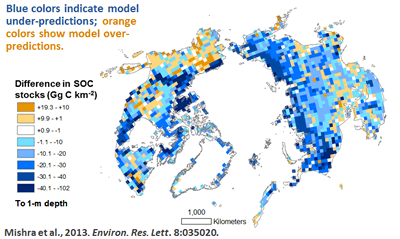Soil Carbon Response to Environmental Change
One of the greatest environmental challenges of the 21st century lies in predicting the impacts of climatic change and other environmental perturbations on Earth's biogeochemical cycles. Soil is a significant component of global biogeochemical cycles because it contains two-thirds of the world's terrestrial carbon (C) stocks and serves as the reservoir for nutrients that support ecosystem productivity.
Although soil organic C stocks were built over thousands of years, these C stores can be susceptible to far more rapid release back to the atmosphere. There are clear regional and local differences in how soils function and in the amount, distribution, and stability of soil organic C stocks. These differences must be accounted for to predict the responses of soils and their C stocks to environmental change and subsequent C feedbacks to the atmosphere.
The Argonne TES SFA conducts fundamental research to quantify and characterize the C stored in soils and evaluate its potential responses to environmental change. Our research
- focuses on regions that are critically sensitive to environmental forcing factors or for which modeling uncertainties are high and
- addresses region-specific factors and processes controlling soil C distributions, their potential responses to environmental forcing, and key knowledge gaps.

At present, our SFA is focusing on soils of the northern circumpolar permafrost region, where huge organic C stocks are preserved mostly by the cold and often wet conditions. Climatic change is already causing widespread permafrost thawing and is likely to increase the decomposition rate of the region's soil C stocks. Return of this C to the atmosphere as the greenhouse gases, carbon dioxide and methane, could feed back to accelerate the rate of global warming. But current observation-based and model estimates of regional soil organic C stocks are both highly uncertain and not in agreement (Figure 1). Even less is known about the potential vulnerability of these C stocks to changing environmental conditions.
Our goal is to quantify the C currently preserved in permafrost-region soils, determine its spatial and vertical distributions, and assess how susceptible this C is to decomposition and release to the atmosphere. We have two major objectives:







